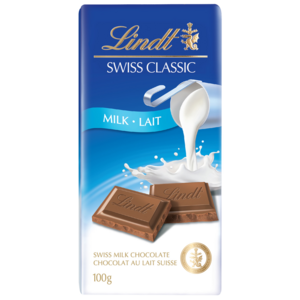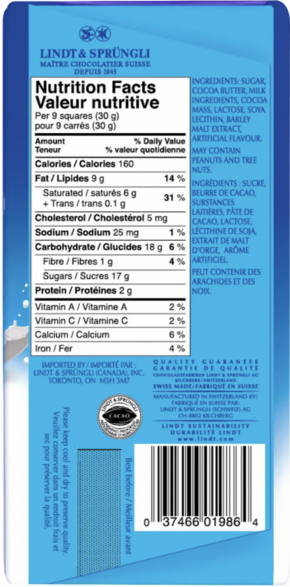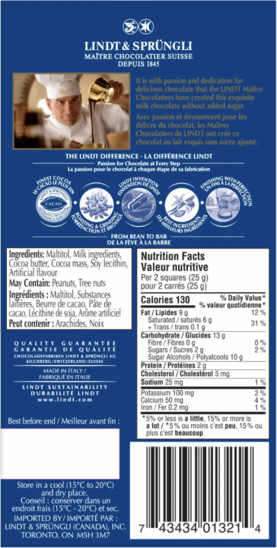Course:FNH200/Assignments/2023/Lindt Milk Chocolate Original vs No Sugar Added
FNH 200 Group 16
Introduction
Lindt Milk Chocolate Original vs. No Sugar Added
Lindt Chocolate is a popular chocolate brand originated from Switzerland in the early 1845[1]. Its famous conching technique creates chocolate that instantly melt in your mouth in a luxuriously smooth, creamy, and delicious way[1]. In this assignment, our group is comparing the Lindt milk chocolate and the Lindt milk chocolate no sugar added version. Both the original milk chocolate and the no sugar version have the same texture, but the no sugar version have added Maltitol as a sugar alternative[1].
Pictures of the Products


Ingredient Lists
| Lindt Milk Chocolate[2] | Lindt Malt Chocolate (No Sugar Added) [3] |
|---|---|
| Sugar | Maltitol |
| Cocoa Butter | Cocoa Butter |
| Milk Ingredients | Milk Ingredients |
| Cocoa Mass | Cocoa Mass |
| Artificial Flavour | Artificial Flavour |
| Soya Lecithin | Soy Lecithin |
| Barley Malt Extract | |
| Lactose |
Compare and Contrast
Similarity in the use of ingredients of the two versions
- Cocoa Butter
- Milk Ingredients
- Cocoa Mass
- Artificial Flavour
Contrast in the use of ingredients of the two versions
- Maltitol
- Barley Malt Extract
- Lactose
The biggest difference in ingredients between Lindt Milk Chocolate and No Sugar Added is the use of Maltitol. Because Maltitol is used as sugar substitute to replace the the sugar in the normal milk chocolate, it provides the sweetness of sugar in Lindt Milk Chocolate, but on a higher sugar percentage. Lactose is used in the the Lindt Milk Chocolate as well, while is not used in the sugar added version. Barley Malt Extract is used as a flavour enhancer in the Lindt Milk Chocolate[4].

Role of Fat Substitutes, Sugar Substitutes, and Additives
| Lindt Milk Chocolate | Lindt Milk Chocolate No Sugar Added | |
|---|---|---|
| Fat Substitutes | N/A | N/A |
| Sugar Substitutes | N/A | Maltitol |
| Additives | Soy Lecithin | Soy Lecithin |
Classic Milk Chocolate
The Classic Milk Chocolate flavour contains soy lecithin as an additive. It is derived from soy, and is generally used as an emulsifier[5]. It is often added to diet supplements, dairy products, bread, and other convenience foods[5].
No Sugar added Milk Chocolate
The sugar-free counterpart to the classic milk chocolate uses Maltitol as a sugar-substitute. Maltitol is a sugar alcohol that is about 90% as sweet as sucrose. It has little effect on blood-sugar levels and does not promote tooth decay; thereby providing a suitable alternative to individuals following a sugar restrictive diet. Maltitol has a similar taste and mouthfeel to sugar, whilst also contributing to the texture and preservation of food items.
The No Sugar Added version uses soy lecithin as an additive too.
The absence of lactose may be noted upon comparison between both flavours. This absence makes the 'no sugar added' flavour not only suitable for diabetics, but for individuals with lactose intolerance as well.
Both versions contain Soy Lecithin. Lecithin acts as an emulsifying agent and is used in various products such as margarine. Soy Lecithin is derived from soybean oil.

Labels
The label provides information in English and French. The Nutrition Facts table provides information regarding the major components of foods available in the product. For instance, for every 9 pieces of chocolate or 30g, there is 160 calories. The fat in the product is 9g which is 14% of daily value. The label also mentions the combined percentage and grams of saturated and trans fat. There is 6g of saturated fat and 0.1g of trans fat which accounts for 31% of daily value. There is 5mg of cholestrol, 25mg of sodium, and 18g of carbohydrates. There is 17 g of sugar in 30 g of chocolate. There is only 1g of fibre and 17g of sugars. There is Vitamin A,C, calcium, and iron also present. Upon examination of the product labels, both Lindt Swiss Classic Milk Chocolate and its No Sugar Added version comply with the food labeling requirements set forth by the Canadian Food Inspection Agency (CFIA).
The labels include all mandatory components such as the common name, net quantity, ingredient list, nutrition facts table, manufacturer's information, and language requirements in English and French. The ingredient lists are presented in descending order by weight, and common food allergens (milk and soy) are clearly declared.
Furthermore, the "No Sugar Added" claim on the Lindt Swiss Classic Milk Chocolate No Sugar Added version is in compliance with CFIA regulations, as no sugars or ingredients that contain sugars have been added, with Maltitol serving as the sweetening agent.
References
Please use the Wikipedia reference style. Provide a citation for every sentence, statement, thought, or bit of data not your own, giving the author, year, AND page.
Note: Before writing your wiki article on the UBC Wiki, it may be helpful to review the tips in Wikipedia: Writing better articles.[6]
- ↑ 1.0 1.1 1.2 Lindt & Sprüngli Canada Inc. (n.d.). Frequently asked questions for Lindt us. Lindt Chocolate Shop USA. https://www.lindtusa.com/lindt-frequently-asked-questions/
- ↑ 2.0 2.1 2.2 "Lindt Milk Chocolate".
- ↑ 3.0 3.1 3.2 "Lindt Milk Chocolate No Sugar Added".
- ↑ Coeliac UK Office. (n.d.). Barley malt vinegar and barley malt extract - suitable for a gluten free diet?. Coeliac UK. https://www.coeliac.org.uk/blog/barley-malt-vinegar-and-barley-malt-extract/#:~:text=Barley%20malt%20extract%20is%20used,be%20legally%20labelled%20gluten%20free.
- ↑ 5.0 5.1 Shaefer, Anna (2019). "Is Soy Lecithin Good or Bad for Me?". Healthline.
- ↑ En.wikipedia.org. (2018). Writing better articles. [online] Available at: https://en.wikipedia.org/wiki/Wikipedia:Writing_better_articles [Accessed 18 Jan. 2018].
| This Food Science resource was created by Course:FNH200. |
